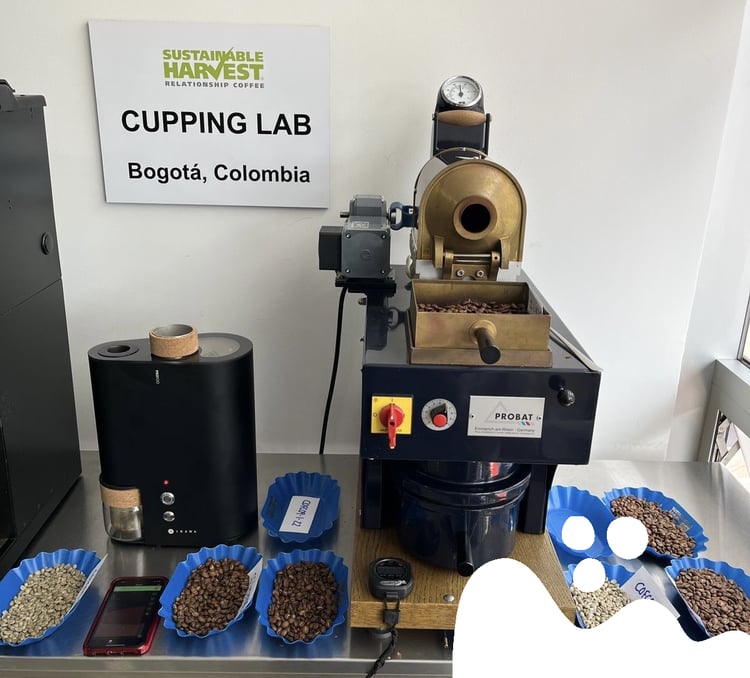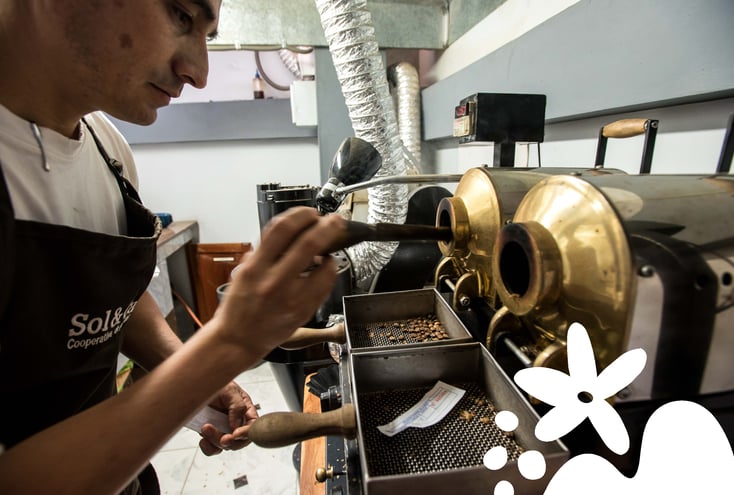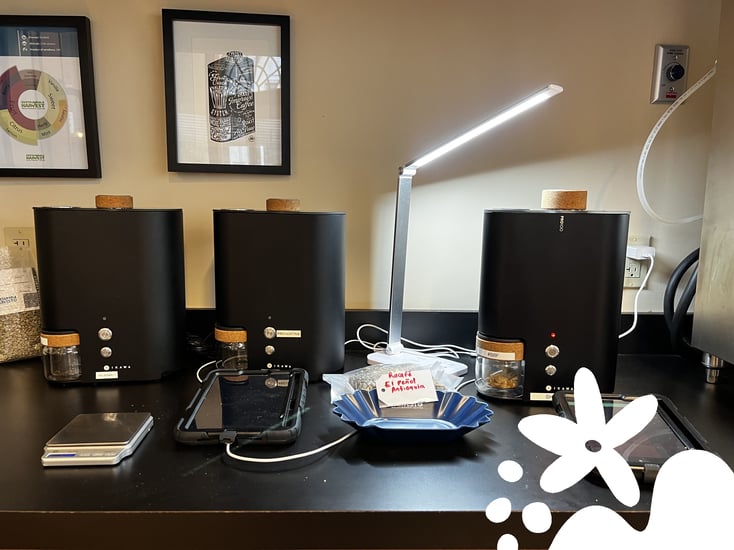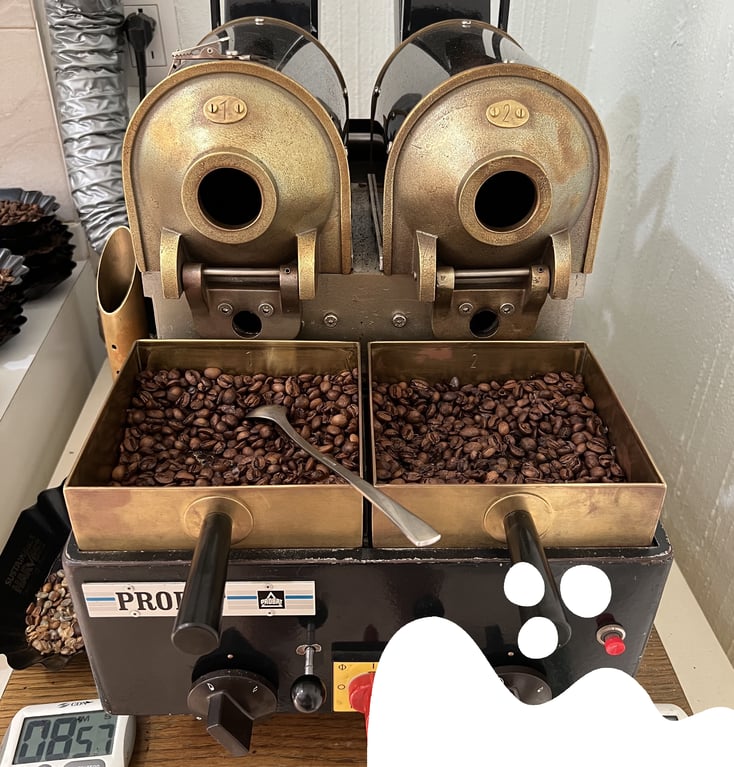
Every coffee professional has likely witnessed the magical transformation of green coffee becoming ready-to-consume beans through the roasting process. During roasting, coffee develops the physical and sensory characteristics it’s known for, and many physical and chemical reactions take place.
For quality-control teams, roasting often takes place in the form of “sample roasting,” or roasting coffee in small batches for evaluation. This process of preparing coffee for tasting is an essential step in quality control, and sample roasting is a craft in itself. Please read on for some insights from our awesome quality-control (QC) team about sample roasting!
________________________________________________
Sample roasting across the supply chain
The craft of roasting requires the user’s senses to be open, and for the professional doing the roasting to engage with the beans as they undergo their transformative process—changing color, cracking, and releasing a fantastic smell. To get the beans to develop in an ideal manner, the user must be fully immersed in what they’re doing by tweaking different variables—such as airflow and temperature—so the coffee reaches its ideal state before cupping. At Sustainable Harvest, our QC team explains that sample roasting helps them bring out the flavors that reflect the hard work of our producer partners, and through that process, we can showcase their passion.
Sample roasting is a vital tool both for QC teams at origin and at the labs where coffee lands at its destination. While some of the details differ for sample roasting at these different locations, it’s important to follow best practices to ensure proper sample roasting takes place throughout the supply chain, including:
At origin:
Quality-control approaches will typically vary widely at farms. You can come across producers with amazing labs who constantly cup their coffees. More commonly, you will find small producers under the umbrella of cooperatives who send their coffee to the co-op lab for careful analysis.
Although in some producing countries quality control only consists of physical analysis, most co-ops will sample roast their beans and cup them at their labs, so the coffee undergoes a quality-control process before being exported. Some origin countries are more strict than others; for example, coffee that is intended for exportation in Colombia must go through various quality-control filters—including sample roasting and cupping—before it’s approved for export.

At the destination lab:
When green coffee lands at its destination—for example, when Sustainable Harvest receives coffee from a producer—it’s then sample roasted and evaluated. The sample roaster is an invaluable tool in this process: The way the roaster is handled and how it’s calibrated or cleaned, are key factors that our QC team needs to make sure are always on point, so we can follow our standards and roast the beans as well as possible. Sample roasting is part of the “everyday life” of any QC lab; our Portland offices roast samples four days a week.
Contrary to QC teams at origin, which mostly cup coffees during harvest seasons, QC teams at the final destination of the coffee, or at importing companies like ours, cup coffees almost every day throughout the year. This means they are constantly roasting samples, because when harvest season finishes in one country, it starts in another, and our team works with many origins.
Coffee Roasters:
After the importer evaluates the coffee, it is sent to the roasters, who also evaluate the beans through sample roasting and cuppings.
Roasters are constantly roasting and cupping samples of offerings they’re interested in, sent either by their importers or directly from origin. Still, besides quality control, roasters often use sample roasting to determine the roasting profile they will be using for specific beans. In addition, sample roasting allows them to play and experiment with the coffee before roasting an entire batch.
Consumers:
Yes, we could say that sample roasting even has a place in the house of the final consumer! Some incredibly committed coffee enthusiasts and home roasters like to roast and cup their coffees, and even keep track of all the coffees they consume. We’ve often come across people who own roasters like the Behmor or the Ikawa —Ikawa even launched a unique line for home roasters—and some of these folks have even started small roasting companies after roasting coffee at home for a while.
So we could say sample roasting has a farm-to-cup journey, from sample roasting at origin to sample roasting at home!

Getting familiar with the equipment
Our QC team explains that sample roasting is most commonly done on drum roasters with a 100g capacity. This small sample size is intentional: For sensory evaluation, you need to cup five cups, and each cup represents about 20% of the sample lot, which is a representative quantity of the whole lot.
To roast coffee at its full potential, it’s key to know your machine inside and out so you can bring out the best from each batch. Some QC people rely on software for dependable sample roasts every time—many roasters have even developed their own programs—while others sample roast by sense and feel. Either way, you need to fully understand your equipment.
If you know your roaster, you know how to control heat and airflow, and how to tweak any variables that will allow you to roast the beans perfectly. Even if it’s an electric machine like the Ikawa, you must know how to develop a perfect profile for each origin and coffee, while still understanding basics like temperature and airflow. Roasting is an art, yes, but a lot depends on how the roaster plays with different variables—anyone can roast coffee, but it is more complex than many people think, which is what truly makes it an art.

Getting to know your beans
Every time our QC team in Portland receives a sample, the first thing they do is a physical analysis of the beans. Then, once the coffee is processed and they know its humidity level, water activity level, and density, they can roast it and then cup it and save the information to the data base or software programs like Tastify.
Because coffee beans have varying levels of density and humidity, not all coffees can be roasted the same way. Humidity, in particular, plays a major role in how the beans will be roasted, the temperature that will be used, and how the roasting curve will behave. For example, we will roast coffees that have a low humidity level using a lower charge temperature and a short drop in the roasting curve, giving them a chance to develop properly. For coffees in Brazil, which are typically low in density, we will usually use the same approach. Conversely, if we have a coffee with high humidity, we will roast it at a higher temperature, as we want it to lose moisture.
But how does water activity play a role in roasting, and how is it different from humidity level? Water activity determines how long the roasting curve can be, as it refers to the water inside the beans, and directly correlates with the chemical reactions taking place inside the beans during the caramelization process. So if the water activity of your coffee is high, the curve can be longer, and those beans will probably hold more heat and airflow. But if the water activity of the beans is low, you’ll want your curve to be slower and smoother to slowly increase the heat and airflow.
These are just a few examples of how knowing your beans and taking variables into account will help you get the most out of your coffee!
________________________________________________
As a roaster, you play one of the most important roles in the coffee supply chain. You can shine a light on the hard work of coffee producers and even impact the price they get for their coffee. Coffee roasting is an incredibly complex and exciting craft that needs to be done carefully, so we encourage you to spend time getting familiar with your sample roaster, playing with some of the aforementioned variables, and honing your sample roasting skills!



.png)
